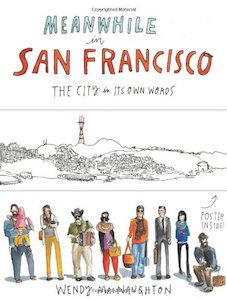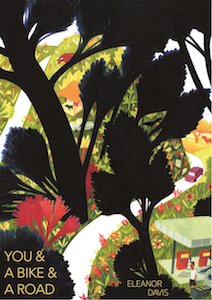Rock Steady: Brilliant Advice from My Bipolar Life by Ellen Forney. Fantagraphics, 2018. 9781683961017.
 Gene: Ellen Forney’s Rock Steady, which is a follow up to…
Gene: Ellen Forney’s Rock Steady, which is a follow up to…
Sarah: Marbles.
G: But this graphic novel is more… advice-y?
S: Yeah. So Marbles was her autobiography about how she figured out she had bipolar. This, years later, is about how she has managed her bipolar. It tells how she has gotten her shit together and how she hopes you can get your shit together, too. It’s based on a lot of work she’s done, and it’s also based on a lot of success that she’s had.
G: It has are other options that she hasn’t explored personally, too, but she’s really clear about what specifically works for her.
S: And she interviews people. I really liked that she interviewed people from a Somali-American health project about how a person’s background and community can really affect what kind of help it feels like you’re allowed to ask for.
G: It was interesting, because it’s local, too, and we know what the Somali health project is because we live in Seattle. I assume that’s not a unique thing, but it’s our thing.
I don’t know exactly how to start talking about this book. I know people who have bipolar disorder, I’ve talked to them about it, a lot of this rings true for me. The thing that I related most to was some of the self-care stuff in the book, which I do when traveling.
S: Yeah.
G: Specifically for my fear of flying, which I manage with a lot of breathing, recognizing when my body is ramping up, and I’d never thought that it’s also a way someone might recognize that they’re heading into a manic episode or a depressive episode, and how much other people have to watch themselves.
The breathing exercises recommended for them were the same as mine, plus just taking time for yourself — it all seems really generally applicable to everybody who has something that troubles them, who has to figure out how to deal with their bodies.
S: Yeah. She talks about the percentage of the population that has bipolar, and it’s not a huge number, but I feel like not only do you want to have this book available for people with bipolar, there’s a lot of overlap with other illnesses and there’s a lot of advice here that’s going to work for people with a variety of issues. You can pick and choose what’s useful to you. There are some things that are much more important for people with bipolar. The chapter on sleep and insomnia is a big issue for her, but I know tons of people who have that problem for other reasons. I think her advice could work for them, too.
G: The insomnia stuff was great. No screen time near bedtime, have a routine…
S: …to let your body know it’s time to chill.
G: She gives a sense that things might change for you, and that you might have to readjust even after something works for a while. Which I’ve had to do around my sleep schedule — the same things don’t always work for me. And that feeds into my fear of flying and my jet lag. When I’m on the road, when I’m doing speaking gigs, it can be just go go go. I have to recognize that I need to take time for myself, that I need to make sure I get enough sleep, otherwise I’m hosed.
S: She talks about finding your warning signs, about red flags — when you know the shit is going down — but also about red flagpoles, which are the circumstances that often lead to your red flags, the things in your life like travel, a big change, or a loss.
G: Reading about seasons as a flagpole, I realized I’ve heard of that before. But being on the outside of it, I don’t get it, so having that reiterated to me was good.
S: And she’s not saying that it’s definitely going to happen, she’s not saying you’re doomed in this circumstance or that, she talks about it in terms of if you know that’s coming up, do all that you can to buffer yourself. You could apply that to your normal life stresses. If you know that going to visit your parents is hard on you, why don’t you make sure that you’re eating a balanced diet before you go so that you’re not all jacked up on sugar. The equivalent of that, but for bipolar.
I’ve got to say, the other thing I really like about this is that there are lots of books on how to manage all sorts of different conditions that are written by doctors, that are written by people with backgrounds in medicine and pharmacology, and they all have good tips, they all know the symptoms and how to manage them, but they haven’t lived it, so they can’t talk to you like a peer would. Because Forney is not only talking about how to deal with medicine, what pills you need to take, etc, she’s also talking about how to make sure you don’t forget to take it, here’s how you take it when you go on the road. She gets into… I think this was in Marbles, too… when you get a diagnosis like this, especially a diagnosis that kinda changes how you can live your life, and changes it when you’re fairly young, that’s a big psychological blow. I didn’t anticipate my life was going to be like this. I didn’t think that I was going to be limited in this way. It can be really hard to take.
G: For some people it’s that the whole this isn’t fair thing. Other people don’t need to worry about this.
S: That’s really baked into the whole book, I really appreciate that.
G: Whereas I liked the pictures.
S: Yeah, the pictures are so good, too.
G: I like the little personal anecdotes, I like the way the pages are laid out, almost like slides for a meeting, an image for each idea. Every page feels very organic, the way the information is packaged. Sometimes there’s a little doodle, sometimes more than a doodle.
S: She’ll go from a cartooney expression to show someone feeling emotions, then switch to more realistic drawings to talk about actual events in her life. She has these great, funny, entertaining ways of talking about… on this page on the importance of having lots of coping tools she has a drawing of a utility belt!
G: Like Batman’s utility belt, but featuring pill dispensers, red alert flags, mood trackers, and compressed sunlight. And a grappling hook, because everyone needs a grappling hook. And tissues.
S: Oh, man, that page on how to cry in public! I think that’s applicable to everybody, I think we need to print that out and have it available in a lot of places.
G: I did that the other day. I can’t remember why.
S: The whole thing is put together in the pattern of an acronym. Other books have acronyms like SMART, but hers is SMEDMERTS! Which she admits is long and unwieldy, but she draws a mascot, a little pig/gremlin creature.
G: It looks like something Elise Gravel might draw.
S: It’s a way to remember the tools you can use to stay Rock Steady. And the book has an index, so you can find what you need when you need it.








